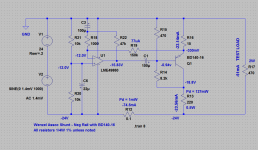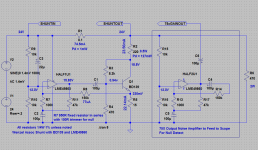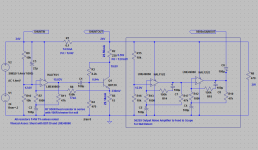KlipschKid - I just realized that you've built the single transistor version of the Wenzel shunt, his figure 1 with the 15R series resistor, rather than the op amp version. I was reading the thread from the bottom up. 
For that one it is the AC noise cancellation voltage dropped across the 15R series resistor that is balanced vs. the incoming ac-coupled noise signal across the emitter resistor of the single transistor inverter, which in turn becomes the shunt current, then creates that equal-but-opposite cancellation voltage in the shunt resistor. So it is that 8.2R emitter resistor you would need to trim, as he notes, not the base voltage.
Same thing applies that I wrote above. You can whip up an ac amplifier to increase the remaining noise signal after the shunt, then feed that to a dmm or software scope to adjust the null. Since your meter's resolution is 1mV you could cascade two of those stages (use both halves of the LM833) for a total gain of 75x75= 5600. A 50uV noise signal would show up as 280mV. Just in this case it would be the emitter resistor you are adjusting. Maybe replace the 8.2R resistor with a 10R fixed that is in parallel with the combo of a 27R fixed in series with your 50R trimmer or a 100R trimmer. That would give you an emitter resistor range of about 7.3R to 9.3R.
For that one it is the AC noise cancellation voltage dropped across the 15R series resistor that is balanced vs. the incoming ac-coupled noise signal across the emitter resistor of the single transistor inverter, which in turn becomes the shunt current, then creates that equal-but-opposite cancellation voltage in the shunt resistor. So it is that 8.2R emitter resistor you would need to trim, as he notes, not the base voltage.
Same thing applies that I wrote above. You can whip up an ac amplifier to increase the remaining noise signal after the shunt, then feed that to a dmm or software scope to adjust the null. Since your meter's resolution is 1mV you could cascade two of those stages (use both halves of the LM833) for a total gain of 75x75= 5600. A 50uV noise signal would show up as 280mV. Just in this case it would be the emitter resistor you are adjusting. Maybe replace the 8.2R resistor with a 10R fixed that is in parallel with the combo of a 27R fixed in series with your 50R trimmer or a 100R trimmer. That would give you an emitter resistor range of about 7.3R to 9.3R.
Last edited:
Hi guys,
Thanks for the help ! I'll measure the AC noise voltage across the series 15R and try to create the same drop across the emitter resistor.
It occurred to me that actually I'm putting the cart before the horse - what I need to focus on is the waveform coming out of the clock and see what effect the Wenzel circuit has, because this is what will make a difference to the sound quality.
Thanks again !
Thanks for the help ! I'll measure the AC noise voltage across the series 15R and try to create the same drop across the emitter resistor.
It occurred to me that actually I'm putting the cart before the horse - what I need to focus on is the waveform coming out of the clock and see what effect the Wenzel circuit has, because this is what will make a difference to the sound quality.
Thanks again !
Hi guys,
Thanks for the help ! I'll measure the AC noise voltage across the series 15R and try to create the same drop across the emitter resistor.
It occurred to me that actually I'm putting the cart before the horse - what I need to focus on is the waveform coming out of the clock and see what effect the Wenzel circuit has, because this is what will make a difference to the sound quality.
Thanks again !
have you try the shunt?
thanks
negative version of the shunt
Hi Agdr and other diyers ,
I hope you have some time to post a schematic for the neg PS version of the wenzel shunt with op amp or the single transistor version .This is for a pre amp
I have built 2 of the shunt wiht the schematic provided by you.
I noted that replacing the 100 UF with a 220 Uf at the output of the op amp is positive.
thanks
kp93300
Hi Agdr and other diyers ,
I hope you have some time to post a schematic for the neg PS version of the wenzel shunt with op amp or the single transistor version .This is for a pre amp
I have built 2 of the shunt wiht the schematic provided by you.
I noted that replacing the 100 UF with a 220 Uf at the output of the op amp is positive.
thanks
kp93300
Here you go. 
Sounds like you are getting some good results! The negative rail circuit is just the mirror of the positive rail Wenzel around ground, with the NPN replaced with a BD140-16 PNP, the electrolytic cap polarities switch, and the op amp supplies connected as shown. A LM833 would be fine for the op amp, of course, I just had the 49860 diagram handy. I've used both on the breadboard. If you want to try the TO-92+heatsink route the PNP transistor would be a 2N4403.
I also noticed a typo in the null test amp schematic I posted before if using a resistor+pot for R7 and trying to maximize the null. The output should be taken directly from the op amp output, not on the other side of C4. Here is a corrected schematic, and a schematic of a two stage test amp. Again the amps will add a lot of their own noise to the test measurement output, but all you are looking for here is a null so it shouldn't matter.
Sounds like you are getting some good results! The negative rail circuit is just the mirror of the positive rail Wenzel around ground, with the NPN replaced with a BD140-16 PNP, the electrolytic cap polarities switch, and the op amp supplies connected as shown. A LM833 would be fine for the op amp, of course, I just had the 49860 diagram handy. I've used both on the breadboard. If you want to try the TO-92+heatsink route the PNP transistor would be a 2N4403.
I also noticed a typo in the null test amp schematic I posted before if using a resistor+pot for R7 and trying to maximize the null. The output should be taken directly from the op amp output, not on the other side of C4. Here is a corrected schematic, and a schematic of a two stage test amp. Again the amps will add a lot of their own noise to the test measurement output, but all you are looking for here is a null so it shouldn't matter.
Attachments
- Status
- This old topic is closed. If you want to reopen this topic, contact a moderator using the "Report Post" button.
- Home
- Amplifiers
- Power Supplies
- wenzel associates finesse shunt


